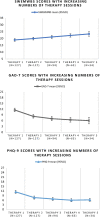Short Warwick-Edinburgh Mental Well-being Scale (SWEMWBS): performance in a clinical sample in relation to PHQ-9 and GAD-7
- PMID: 34819104
- PMCID: PMC8611866
- DOI: 10.1186/s12955-021-01882-x
Short Warwick-Edinburgh Mental Well-being Scale (SWEMWBS): performance in a clinical sample in relation to PHQ-9 and GAD-7
Abstract
Purpose: This study assesses the construct validity and sensitivity to change of the Short Warwick-Edinburgh Mental Well-being Scale (SWEMWBS) as an outcome measure in the treatment of common mental disorders (CMD) in primary care settings.
Methods: 127 participants attending up to 5 sessions of therapy for CMD in primary care self-rated the SWEMWBS, the Patient Health Questionnaire (PHQ-9) and General Anxiety Disorder (GAD-7) scales. SWEMWBS's construct validity and sensitivity to change was evaluated against the PHQ-9 and GAD-7 across multiple time points in two ways: correlation coefficients were calculated between the measures at each time point; and sensitivity to change over time was assessed using repeated measures ANOVA.
Results: Score distributions on SWEMWBS, but not PHQ-9 and GAD-7, met criteria for normality. At baseline, 92.9% (118/127) of participants scored above clinical threshold on either PHQ-9 or GAD-7. Correlations between SWEMWBS and PHQ-9 scores were calculated at each respective time point and ranged from 0.601 to 0.793. Correlations between SWEMWBS and GAD-7 scores were calculated similarly and ranged from 0.630 to 0.743. Significant improvements were seen on all three scales over time. Changes in PHQ-9 and GAD-7 were curvilinear with greatest improvement between sessions 1 and 2. Change in SWEMWBS was linear over the five sessions.
Conclusions: This exploratory study suggests that SWEMWBS is acceptable as a CMD outcome measure in primary care settings, both in terms of construct validity and sensitivity to change. Given patient preference for positively over negatively framed measures and statistical advantages of measures which are normally distributed, SWEMWBS could be used as an alternative to PHQ-9 and GAD-7 in monitoring and evaluating CMD treatment.
Keywords: Anxiety; Clinical; Counselling; Depression; GAD-7 mental wellbeing; Outcome measure; PHQ-9; Primary care; SWEMWBS.
© 2021. The Author(s).
Conflict of interest statement
Sarah-Stewart Brown is the developer of the Warwick-Edinburgh Mental Wellbeing Scale. William Andrews is the developer of Pragmatic Tracker software used to capture data.
Figures
Similar articles
-
Psychometric properties of the short Warwick Edinburgh mental well-being scale (SWEMWBS) in service users with schizophrenia, depression and anxiety spectrum disorders.Health Qual Life Outcomes. 2017 Aug 1;15(1):153. doi: 10.1186/s12955-017-0728-3. Health Qual Life Outcomes. 2017. PMID: 28764770 Free PMC article.
-
Patient-reported outcome measures in community mental health teams: pragmatic evaluation of PHQ-9, GAD-7 and SWEMWBS.BJPsych Bull. 2019 Oct;43(5):221-227. doi: 10.1192/bjb.2019.20. Epub 2019 Mar 22. BJPsych Bull. 2019. PMID: 30898178 Free PMC article.
-
Improved lifestyle is associated with improved depression, anxiety and well-being over time in UK healthcare professionals during the COVID-19 pandemic: insights from the CoPE-HCP cohort study.Gen Psychiatr. 2023 Jan 20;36(1):e100908. doi: 10.1136/gpsych-2022-100908. eCollection 2023. Gen Psychiatr. 2023. PMID: 36751400 Free PMC article.
-
The reliability and validity of the Chinese Short Warwick-Edinburgh Mental Well-being Scale in the general population of Hong Kong.Qual Life Res. 2019 Oct;28(10):2813-2820. doi: 10.1007/s11136-019-02218-5. Epub 2019 May 29. Qual Life Res. 2019. PMID: 31144205
-
Evaluating and establishing national norms for mental wellbeing using the short Warwick-Edinburgh Mental Well-being Scale (SWEMWBS): findings from the Health Survey for England.Qual Life Res. 2017 May;26(5):1129-1144. doi: 10.1007/s11136-016-1454-8. Epub 2016 Nov 16. Qual Life Res. 2017. PMID: 27853963 Free PMC article.
Cited by
-
Personalised & optimised therapy (POT) algorithm using five cognitive and behavioural skills for subthreshold depression.NPJ Digit Med. 2025 Aug 20;8(1):531. doi: 10.1038/s41746-025-01906-6. NPJ Digit Med. 2025. PMID: 40835713 Free PMC article.
-
The Mental Wellbeing of Child and Adolescent Mental Health Service (CAMHS) Workers in England: A Cross-Sectional Descriptive Study Reporting Levels of Burnout, Wellbeing and Job Satisfaction.Healthcare (Basel). 2024 Feb 7;12(4):430. doi: 10.3390/healthcare12040430. Healthcare (Basel). 2024. PMID: 38391806 Free PMC article.
-
Roots and Shoots: A Pilot Parallel Randomised Controlled Trial Assessing the Feasibility and Acceptability of a Nature-Based Self-Help Intervention for Low Wellbeing.Behav Sci (Basel). 2025 Aug 12;15(8):1096. doi: 10.3390/bs15081096. Behav Sci (Basel). 2025. PMID: 40867453 Free PMC article.
-
Validation and psychometric evaluation of the Short Warwick-Edinburgh Mental Well-Being Scale (SWEMWBS) among Czech adolescents using Item Response Theory.Health Qual Life Outcomes. 2024 Aug 19;22(1):66. doi: 10.1186/s12955-024-02280-9. Health Qual Life Outcomes. 2024. PMID: 39160537 Free PMC article.
-
Emerging From a Two-Year-Long Quarantine: A Retrospective Study on Life Satisfaction Trajectory and Depression Among Young LGBTQ+ Students in the Philippines.SAGE Open Nurs. 2023 Feb 23;9:23779608231158980. doi: 10.1177/23779608231158980. eCollection 2023 Jan-Dec. SAGE Open Nurs. 2023. PMID: 36861049 Free PMC article.
References
-
- Faculty of Public Health and Mental Health Foundation. Better Mental Health for All: A Public Health Approach to Mental Health Improvement. 2016.
-
- Jahoda M. Current concepts of positive mental health. J Occupational Environ Med. 1959;1(10):565.
-
- Organization WH. Joint meeting of experts on targets and indicators for health and well-being in Health 2020: Copenhagen, Denmark, 5–7 February 2013. 2013.
MeSH terms
LinkOut - more resources
Full Text Sources
Medical
Miscellaneous


